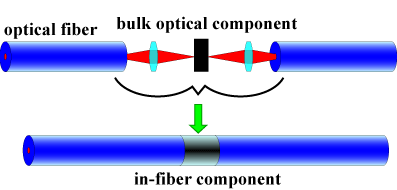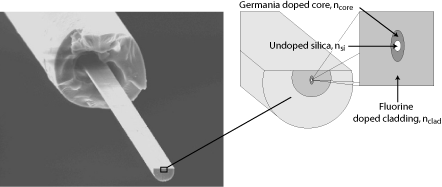In-Fiber Devices
Optical fiber communication systems use a variety of in-line components
such as modulators, attenuators, amplifiers, filters, etc. These in-line
components are typically produced by coupling the light out of the optical
fiber and into some bulk or integrated optical waveguide device and then back into
the optical fiber. The goal of this research is to produce devices entirely within
the optical fiber domain.
 D-Shaped Optical Fiber
D-Shaped Optical Fiber
In-fiber optical devices require access of the light guided in
the core of the optical fiber.
D-shaped optical fibers have a 'D' shape with the core close to the
flat surface.
The top of the core is approximately 10 microns from the surface.

The D-shaped fibers that we use are manufactured by
KVH Industries. They are polarization mantaining
fibers with an elliptical core. The elliptical core can have an orientation with the major axis either parallel or perpendicular to the
flat surface of the fiber.
Device Operation
The glass used in optical fibers is fairly insensitive to external signals. This insensitivity is desireable
when the fiber is used as a transmission medium. Since it is hard to alter the light guided by the fiber,
it is difficult to create active components such as modulators, tunable filters, etc. or create optical sensors.
In our research we have developed a method to replace a section of the optical fiber core with a different
material. The new material could be a material with higher optical nonlinearites such as an electro-optic polymer
or it could be a material sensitive to a particular chemical.
Fabrication Process
(Click on the process step for more detail.)
